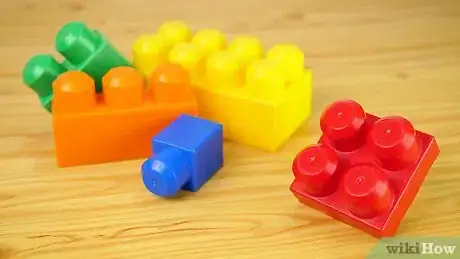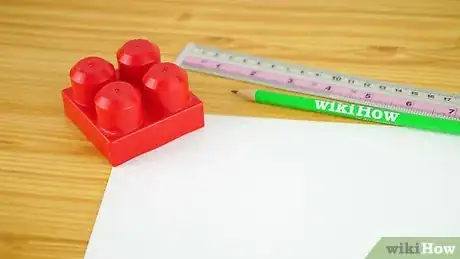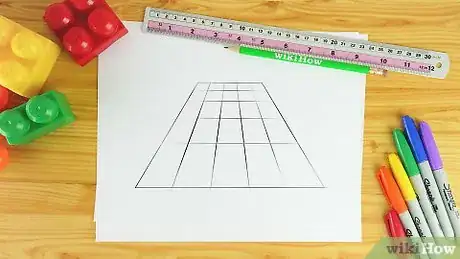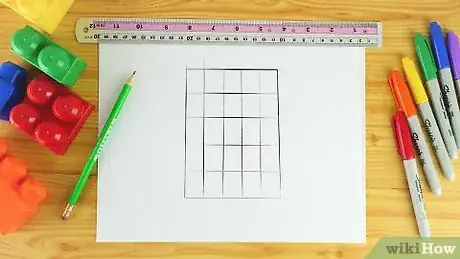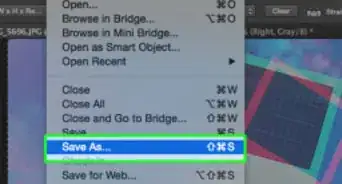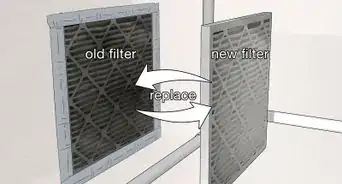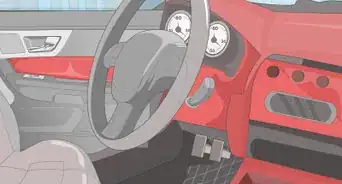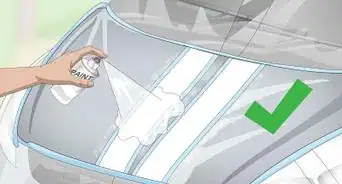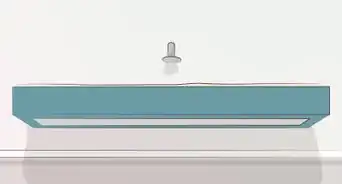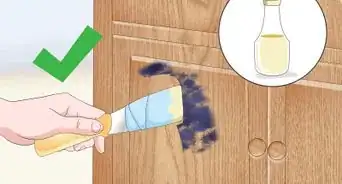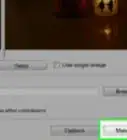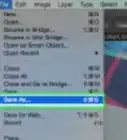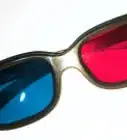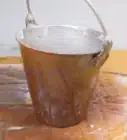This article was co-authored by Laura M. Johnson and by wikiHow staff writer, Amy Bobinger. Laura M. Johnson is a Mural Artist and the Owner of Laura Margo Murals & Custom Art in St. Paul, Minnesota. She has over five years of experience in the industry and has worked professionally across venture capital, communications, the arts, and beyond. She helps empower small and growing businesses to find their voices, share their stories, and grow their impact. Laura received her Master of Business Administration from the University of Minnesota - Carlson School of Management, and her Bachelors in Journalism and Communication Studies with a minor in Fine Arts from the University of Oregon.
There are 11 references cited in this article, which can be found at the bottom of the page.
This article has been viewed 31,709 times.
You may have seen 3D paintings that looked like an object was actually coming up out of the surface of the drawing. This style of art, known as anamorphosis, is thought to be an ancient technique. However, in recent years it’s enjoyed a return to popularity, and it's been seen everywhere from simple line drawings to elaborate sidewalk art. While some artists use computers to create the effect, you can make your own 3D painting by using 2 graphs and some simple shading and perspective techniques!
Steps
Drawing the Object in Perspective
-
1Decide what you want to draw. You can turn almost anything into a 3D painting. If you’re just getting started, though, it’s probably best to start with something simple, like a cube or a sphere. Once you get the techniques down, you can move on to more elaborate objects.
- If you’d like to try an intermediate technique, try drawing a glass of water or a single flower in a vase.
- Take a picture of your desired subject matter so you can attempt to copy each detail and the colors of the photo in your painting.
-
2Choose the spot where you’ll need to stand to see the 3D effect. When you create an anamorphic painting, the object will only look 3D when you look at it from a certain angle. This spot is known as the “photo point.” As you're planning out the drawing, consider the viewer’s perspective, whether that’s looking down onto the painting or looking at it from an angle.[1]
- If you’re creating the painting on a canvas, you’ll be able to move around to get the effect, but if you’re planning a large installation, you’ll need to carefully plan the perspective based on where the viewers will be most likely to stand.
Tip: If you're planning a large installation that will go on the walls of a room, consider using a projector to display the image on the walls at eye level, or about 5 ft (1.5 m). Then, paint over that to create the optical illusion.[2]
Advertisement -
3Draw a line graph with vanishing perspective lines. Once you know where you want your photo point to be, use a ruler to draw a graph with angled lines so it looks like the graph is trailing into the distance. The bottom of the graph (typically the part closest to the photo point) should be the widest, then it should become more narrow the further up the page it goes. The more dramatically you angle the lines, the larger the object will seem.[3]
- Don’t make the squares too small, or it will be hard to see the details of your drawing. The number of lines you’ll use will depend on the size of your drawing, but for a simple sketch, a 5x5 grid is a good place to start.
- You may want to label the rows and columns with numbers and letters to help you keep track of each square.
- Even if you're planning on making a large sidewalk drawing, starting with these graphs can help you plan out your design. You’ll just have to scale it larger once you start working on the actual installation.
-
4Draw a square grid on a new sheet of paper or canvas. This square grid will be where you actually create the drawing. Use a ruler to make sure your lines are perfectly straight, and create the grid with the same number of squares and columns as you used for the angled grid.[4]
- If you don't want to see the lines when you're finished, draw them lightly, then erase them after you draw the object.
- If you’re making a larger installation, you can tape off squares on the ground or wall rather than using a separate piece of paper. However, it can be helpful to practice drawing the object on paper before taking on a bigger project.
-
5Sketch your drawing onto the angled graph. There’s no need to try to skew the perspective here; just draw the object onto the angled graph the same way you would if you were drawing on blank paper. However, try to keep the image inside the grid, since you’ll use the lines as a reference point when you transfer it to the final canvas.[5]
- You can also use photo editing software to overlay the image onto an angled graph, but this isn’t necessary.
-
6Copy the image onto the square graph so it matches the angled graph. Once you’ve finished drawing your picture on the angled graph, place it somewhere where you can see it easily, then start drawing the image onto your square graph, making sure the image matches each square of the grid.[6]
- For instance, if you’re drawing a sphere and it passes through the bottom left square on the angled grid, you would make sure to add the same curved line to the bottom left square on the second graph as well.
- The picture will likely look normal in the bottom squares, but the further up the paper you go, the more you’ll have to stretch the image so it fits the squares. This will create a distorted appearance, which is necessary to create the 3D illusion.
- Don’t worry about filling in much detail here. Just try to get the main outline of the object onto the grid.
Adding Light and Shadows
-
1Decide where your light source will come from. After you’ve finished drawing your object, it’s time to add shading, which is how you’ll create the impression that the object is actually taking up space. Before you start shading, think about where the light in your picture is coming from. Typically, light comes from overhead, such as the sun or a ceiling lamp, but it’s usually angled slightly, rather than straight on.[7]
- To make the 3D effect more realistic, study the lighting in the area where you plan to display the painting. This is especially important if the painting will be an installation. For instance, if there’s a street sign nearby, consider how that would affect the lighting in your painting.
Tip: Light reflects differently on objects with different textures. It reflects more off of smooth, slick surfaces, for example, than it does off of rough surfaces, so pay attention to what your item is made out of.
-
2Add highlights wherever the light would naturally hit. Whether you’re planning on using greyscale or color for your 3D painting, the same principles of shading will apply. The parts of your object that are closest to the light should have the lightest hues, with darker shades in areas that are farthest from the light.[8]
- It may help to do an image search in your search engine for a “value scale,” which shows the range of values for a certain color from lightest to darkest. Gray value scales can be especially useful if you’re not using color in your painting.
- If you're using color, use at least 2 shades of the same color to produce a light and dark effect. Place the lighter shade wherever the light would hit the object. You can also use yellow on top of your lighter color as a highlight to mimic the warmth of your light source.[9]
-
3Use darker colors to create shading farther away from the light. If you're using multiple shades, switch to a darker color to start adding in shading, or use heavier strokes if you're drawing in pencil. For now, primarily focus on shading the form of the object itself, rather than the shadow it casts onto the ground.[10]
- Seeing the object taking on shape and weight can help you draw the cast shadow later.
- Unless you’re shading around a sharp corner, shadows should typically fade into each other.
-
4Fill in any details that are remaining. Typically, most of the details in a painting will naturally emerge as you're adding in the shading and highlights. However, if you need to fill in any finishing touches, like decorative embellishments or color adjustments, add them now.
- For instance, if you're drawing a Rubik's cube, you would draw the individual squares and add color to them, paying attention to how the shadows and highlights would affect each hue.
-
5Add the shadow that’s cast by the object. Drawing shadows can be tricky, so take your time to think about what it should look like. Consider the shadow that your object would create, and try to mimic that as closely as possible. Remember, it needs to look like there’s really an object making a shadow on the paper or canvas.[11]
- Think about how translucent areas, reflected light, liquids, or other objects might affect your shadow.
- If you’re using a physical object as a model, study its actual shadow to help you get an idea of what to draw.
-
6Cut along the top of the page to make the image look like it’s standing up. One of the most popular techniques to use when you’re creating a 3D painting is to cut along the top of the image. To do this, choose a point somewhere near the top of the page, but below the top of the image. Use a ruler to draw a straight line on either side of the image, then cut carefully along the line and around the top of the form you drew.[12]
- If you don’t want to do this, you may want to draw some sort of a background onto the canvas to help the viewer understand what they’re looking at. You may want to draw a straight line to indicate a table, for instance.
-
7Stand at the photo point if you want to take a picture of your painting. Once you’re finished with your painting, you may want to take a picture to show it off to your friends or post on social media. If so, lay the canvas flat on a table, then move around until you find the photo point, or the spot where the 3D point becomes apparent, then snap away!
- You may even want to take a video, starting from the photo point and moving forward until it becomes clear that the object is actually a 2D drawing.
Expert Q&A
-
QuestionHow do you make 3D art more easily?
 Laura M. JohnsonLaura M. Johnson is a Mural Artist and the Owner of Laura Margo Murals & Custom Art in St. Paul, Minnesota. She has over five years of experience in the industry and has worked professionally across venture capital, communications, the arts, and beyond. She helps empower small and growing businesses to find their voices, share their stories, and grow their impact. Laura received her Master of Business Administration from the University of Minnesota - Carlson School of Management, and her Bachelors in Journalism and Communication Studies with a minor in Fine Arts from the University of Oregon.
Laura M. JohnsonLaura M. Johnson is a Mural Artist and the Owner of Laura Margo Murals & Custom Art in St. Paul, Minnesota. She has over five years of experience in the industry and has worked professionally across venture capital, communications, the arts, and beyond. She helps empower small and growing businesses to find their voices, share their stories, and grow their impact. Laura received her Master of Business Administration from the University of Minnesota - Carlson School of Management, and her Bachelors in Journalism and Communication Studies with a minor in Fine Arts from the University of Oregon.
Mural Artist Keep practicing! It can take many years, if not a lifetime, to become a master of this art style. Don't be frustrated if you don't achieve perfect results right away—eventually, you will train your eye to pick up nuances in light and shadow, which will help your work look more 3D.
Keep practicing! It can take many years, if not a lifetime, to become a master of this art style. Don't be frustrated if you don't achieve perfect results right away—eventually, you will train your eye to pick up nuances in light and shadow, which will help your work look more 3D.
Things You’ll Need
- At least 2 pieces of paper or canvas
- Ruler
- Pencil
- Colored pencils, paint, etc (optional)
- Scissors (optional)
References
- ↑ https://www.caea-arteducation.org/assets/2014Conference/WorkshopLessonPlans/mcfaul%20-%20anamorphic%20projection%20-%20photo%20setup.pdf
- ↑ https://medium.com/@tqvinn/the-secret-to-anamorphic-illusions-853e3674209a
- ↑ https://youtu.be/xzLwBLWKBr8?t=517
- ↑ https://youtu.be/xzLwBLWKBr8?t=761
- ↑ https://youtu.be/oIPSBWv7uHY?t=49
- ↑ https://youtu.be/oIPSBWv7uHY?t=87
- ↑ http://www.artinstructionblog.com/drawing-lesson-a-theory-of-light-and-shade
- ↑ https://youtu.be/oIPSBWv7uHY?t=173
- ↑ https://youtu.be/oIPSBWv7uHY?t=173
About This Article
To make a 3D painting, start by choosing a simple object to paint, like a cube or sphere. Once you’ve selected the object, paint it on your chosen canvas or paper, making sure to stretch the image out so that it gets wider the farther you go up the page. After you’ve finished painting, add light and shading to it, which will help create the impression that your object is taking up space. For example, you could color the parts of your cube or sphere that are closer to the light source with lighter colors, and use darker shades on the parts that are farther away. You should also add the shadow your object will create, which will make it appear more realistic. If you’re struggling to get the shadow right, try studying a physical object to see how the shadow looks in real life, then copy it. For tips on how to take a photo of your painting, read on!
